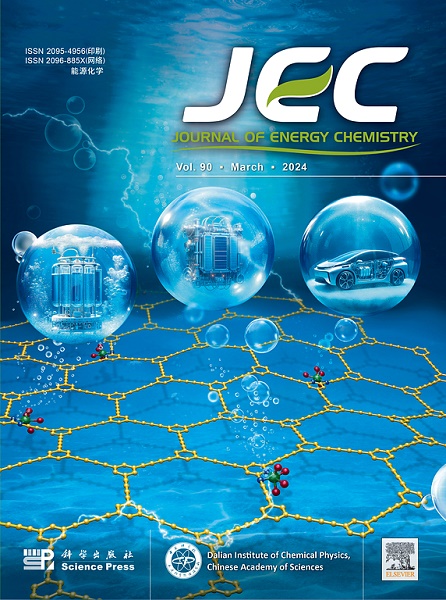InterOptimus:一种人工智能辅助的强大工作流程,用于筛选锂电池中的基态非均质界面结构
IF 13.1
1区 化学
Q1 Energy
引用次数: 0
摘要
包括阴极-电解质间相(CEI)和固体-电解质间相(SEI)在内的间相层的形成具有显著的化学复杂性,对锂电池的性能起着关键作用。尽管在模拟电池材料的体相特性方面取得了相当大的进步,但对界面的理解,包括代表最简单情况的晶体界面,仍然有限。这主要是由于对界面微观结构进行基态搜索的挑战以及与第一性原理方法相关的高计算成本。在这里,我们介绍InterOptimus,一个自动化的工作流程,旨在有效地搜索基态异构接口。InterOptimus结合了一个严格的,对称感知等效分析晶格匹配和终端扫描。此外,它还介绍了立体投影作为直观和全面的框架,用于界面结构的可视化和分类。通过集成通用机器学习原子间势(MLIPs), InterOptimus能够快速预测界面能量和稳定性,显着降低密度泛函理论(DFT)中必要的计算成本超过90%。我们在三个关键的锂电池界面,Li2S|Ni3S2, LiF|NCM和Li3PS4|Li上对几种MLIPs进行了基准测试,并证明MLIPs在建模势能面和排序界面稳定性方面达到了与DFT相当的精度。因此,InterOptimus促进了基态非均相界面结构的有效确定和后续结构-性能关系的研究,加速了新型电池材料的界面工程。本文章由计算机程序翻译,如有差异,请以英文原文为准。

InterOptimus: An AI-assisted robust workflow for screening ground-state heterogeneous interface structures in lithium batteries
The formation of interphase layers, including the cathode-electrolyte interphase (CEI) and solid-electrolyte interphase (SEI), exhibits significant chemical complexity and plays a pivotal role in determining the performance of lithium batteries. Despite considerable advances in simulating the bulk phase properties of battery materials, the understanding of interfaces, including crystalline interfaces that represent the simplest case, remains limited. This is primarily due to challenges in performing ground-state searches for interface microstructures and the high computational costs associated with first-principles methods. Herein, we introduce InterOptimus, an automated workflow designed to efficiently search for ground-state heterogeneous interfaces. InterOptimus incorporates a rigorous, symmetry-aware equivalence analysis for lattice matching and termination scanning. Additionally, it introduces stereographic projection as an intuitive and comprehensive framework for visualizing and classifying interface structures. By integrating universal machine learning interatomic potentials (MLIPs), InterOptimus enables rapid predictions of interface energy and stability, significantly reducing the necessary computational cost in density functional theory (DFT) by over 90%. We benchmarked several MLIPs at three critical lithium battery interfaces, Li2S|Ni3S2, LiF|NCM, and Li3PS4|Li, and demonstrated that the MLIPs achieve accuracy comparable to DFT in modeling potential energy surfaces and ranking interface stabilities. Thus, InterOptimus facilitates the efficient determination of ground-state heterogeneous interface structures and subsequent studies of structure-property relationships, accelerating the interface engineering of novel battery materials.
求助全文
通过发布文献求助,成功后即可免费获取论文全文。
去求助
来源期刊

Journal of Energy Chemistry
CHEMISTRY, APPLIED-CHEMISTRY, PHYSICAL
CiteScore
19.10
自引率
8.40%
发文量
3631
审稿时长
15 days
期刊介绍:
The Journal of Energy Chemistry, the official publication of Science Press and the Dalian Institute of Chemical Physics, Chinese Academy of Sciences, serves as a platform for reporting creative research and innovative applications in energy chemistry. It mainly reports on creative researches and innovative applications of chemical conversions of fossil energy, carbon dioxide, electrochemical energy and hydrogen energy, as well as the conversions of biomass and solar energy related with chemical issues to promote academic exchanges in the field of energy chemistry and to accelerate the exploration, research and development of energy science and technologies.
This journal focuses on original research papers covering various topics within energy chemistry worldwide, including:
Optimized utilization of fossil energy
Hydrogen energy
Conversion and storage of electrochemical energy
Capture, storage, and chemical conversion of carbon dioxide
Materials and nanotechnologies for energy conversion and storage
Chemistry in biomass conversion
Chemistry in the utilization of solar energy
 求助内容:
求助内容: 应助结果提醒方式:
应助结果提醒方式:


